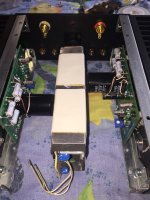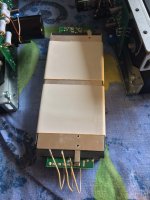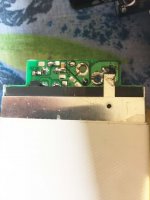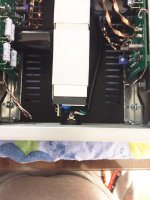Sure, there you go...
Interesting, which SMPS did you use.
What is the difference between version 1.1 and 1.6?
If your board is marked ''Amp Camp 1.1'' - the only differences are slight layout changes on the ''ACA 1.6'' board. Component values are the same.
If you built it from a V1.5 kit, then the difference between the V1.5 kit (with Amp Camp 1.1 board) and V1.6 kit (with ACA 1.6 board) is the power supply. The V1.5 kit has a 19 volt supply and the V1.6 kit has a 24 volt supply for a small increase in output power.
You can replace a 19 volt PSU with a 24 volt version if needed. Just reset the 'Bias' to 12 volts instead of 10 volts. See step 52 of the V1.6 build guide Amp Camp Amp V1.6 Build Guide - diyAudio Guides
PS. If you do have an earlier version of the board i.e. ''Amp Camp #1'' then there are considerable layout changes. But the basic circuit is the same.
Differences were the feedback resistor R12 was 68K and is now 39k. And R15 (2.2k ohms) was not fitted on earlier boards. To fit R15 (recommended) on a board without location holes please see post #2 here: ACA illustrated build guide You can use a 24 volt supply here too as long as the 'Bias' is set to 12 volts.
Last edited:
Please do provide more info about the "cap multipliers". I'm not familiar with that term.
Have a read at this:
Capacitance Multiplier Power Supply Filter
Interesting, which SMPS did you use.
It is the SMPS that comes with the ACA kit. I removed it from the plastic box and soldered few wires. The switch that comes with the ACA kit is good for 5A / 250V AC and it works no problem because it switches the "low current side" - the AC side.
For all those interested in doing this - placing the SMPS inside the ACA, be warned: this requires work with lethal voltages, proceed ONLY if you wish to do so, and at your own risk.
Attachments
Last edited:
It is the SMPS that comes with the ACA kit. I removed it from the plastic box and soldered few wires. The switch that comes with the ACA kit is good for 5A / 250V AC and it works no problem because it switches the "low current side" - the AC side.
For all those interested in doing this - placing the SMPS inside the ACA, be warned: this requires work with lethal voltages, proceed ONLY if you wish to do so, and at your own risk.
Now I see....neat solution.
Also have a look at post #5630 where I described how I've implemented the Cap Mx in my ACA.
Also have a look at post #5630 where I described how I've implemented the Cap Mx in my ACA.
Thanks
Just out of curiosity, I wired up another MW LRS-150-24v supply effectively making a pair of mono blocks in the one case, for less than $20 I had to give it go.

A bit DIY and a work in progress...
Was it worth it?, yes it was for me, not a huge lift but discernible, bottom end grunt has a tad more weight top sweeter. Though I am a bit surprised (or not) as the ACA (with tungsten mods by the way) sounds better than my F5t or Id rather, after a few weeks, listen to the ACA than the F5t. WTF!!!

A bit DIY and a work in progress...
Was it worth it?, yes it was for me, not a huge lift but discernible, bottom end grunt has a tad more weight top sweeter. Though I am a bit surprised (or not) as the ACA (with tungsten mods by the way) sounds better than my F5t or Id rather, after a few weeks, listen to the ACA than the F5t. WTF!!!
Last edited:
Questions Re the shop universal power supply boards - One set of boards would do a pair of ACA?
Transformers for the above One 300VA transformer with two 24 volt outputs or two single 150VA with one output each?
Considering building one box with enough boards and outlets to do two ACA the Korg and maybe a Pearl two phono setup in the future - What would work?
Thanks
Steve
Transformers for the above One 300VA transformer with two 24 volt outputs or two single 150VA with one output each?
Considering building one box with enough boards and outlets to do two ACA the Korg and maybe a Pearl two phono setup in the future - What would work?
Thanks
Steve
A transformer with 20V secondaries will yield about 24.5V rails using conventional diode bridge rectifiers and CRC filtration. A single “Universal PSU” board could be used for a pair of positive supply rails, as long as one was careful to reverse the polarity of the capacitors on one side of the board. I like 300VA transformers for this, but 250VA should suffice.
I´m a little taken aback by the size of the transformers.
I´m using several 160VA transformers. One with 0-18v x 2 and another with 0-15v x 2. We would be talking about 5.3 Amp and 4.4 Amp per secondary.
In both cases and with two "standard PSU" (one secondary/psu for channel) my ACA works correctly (I have a little more than 19Vdc and 24Vdc with load). The consumption per channel is around 1.4 Amps at rest.
I have also been using a 19Vdc @ 5A switched PSU and I have not had problems either. It is also true that my speakers / headphones are not very demanding, but... Maybe I'm missing something? Should I use both secondary in parallel?
I´m using several 160VA transformers. One with 0-18v x 2 and another with 0-15v x 2. We would be talking about 5.3 Amp and 4.4 Amp per secondary.
In both cases and with two "standard PSU" (one secondary/psu for channel) my ACA works correctly (I have a little more than 19Vdc and 24Vdc with load). The consumption per channel is around 1.4 Amps at rest.
I have also been using a 19Vdc @ 5A switched PSU and I have not had problems either. It is also true that my speakers / headphones are not very demanding, but... Maybe I'm missing something? Should I use both secondary in parallel?
The ACA 1.6 kit is designed and supplied with a 24 volt 5 amp brick. I asked the question about the universal power supply because in other threads the secondary voltage is less than required until rectified and filtered after which it jumps up. It also produces positive and negative DC voltages for Pass designed Amps but not suitable for the ACA without modifying it as per previous post. I need to read up on how you flip the polarity like that using capacitors.
I have tried both 200VA and 300VA transformers in my ACA-200 builds. (See the ACA with premium parts thread.) At the time I was working on a better way to get higher voltage power rails. The 200VA transformer with 25V secondaries was unable to maintain its rated voltage at the inputs of the bridge rectifiers. When I switched to a 300VA transformer with 24V secondaries, it met its performance specification, and my amp sounded better as a result. That was the ACA-220 v2. Each channel is powered by a little over 28 Volts after the CRCRC filter. It is effectively a dual-mono amp with independent secondaries for each channel.
Since the process of producing DC power with a bridge rectifier and CRC filtering isn't very efficient, it is not valid to compare current ratings of the transformer secondary windings to the regulated output of an SMPS. The transformer windings need to be rated for greater current in order to effectively regulate the linear power supply.
I have voiced my ACA builds to drive older speakers of medium efficiency, and to be run at higher power levels while doing so.
Recently, I decided to re-purpose the 300VA, 22V transformer in my ACA-220 v1 for another project. Rather than installing the spare 300VA, 24V transformer that was available, I rebuilt the amp to use a MeanWell RSP-150 27 Volt SMPS. This PSU is rated for 5.6 Amps. I replaced the CRCRC filter with a simple 220 uF - 0.11 Ohm - 4700 uF filter. Listening tests following a 24 hour break-in period sounded promising. Imaging and transparency were both quite good, and I had fun listening to a couple albums with this amp. After a while, I got the sense that even with its positive characteristics, the amp was sounding a bit thin in the lower octave or two. Switching to my ACA-220 v2 confirmed this. With the music properly supported by a better bass foundation, each recording sounded better. The dynamics and detail were both improved from top to bottom with the linear PSU configuration.
Sometimes it is important to compare different amps to each other within a short period of time. I am fortunate to have two alternate builds available to do this. Plus I also have a couple of Papa's larger designs to play with. The Aleph J, for example, still trounces the ACA-220 v2.
Now I am trying to decide whether to find a clever way to wedge a second 150 Watt SMPS into v1, or to re-build it again with the 300VA, 24V transformer. Either way, it's going back to dual-mono.
Since the process of producing DC power with a bridge rectifier and CRC filtering isn't very efficient, it is not valid to compare current ratings of the transformer secondary windings to the regulated output of an SMPS. The transformer windings need to be rated for greater current in order to effectively regulate the linear power supply.
I have voiced my ACA builds to drive older speakers of medium efficiency, and to be run at higher power levels while doing so.
Recently, I decided to re-purpose the 300VA, 22V transformer in my ACA-220 v1 for another project. Rather than installing the spare 300VA, 24V transformer that was available, I rebuilt the amp to use a MeanWell RSP-150 27 Volt SMPS. This PSU is rated for 5.6 Amps. I replaced the CRCRC filter with a simple 220 uF - 0.11 Ohm - 4700 uF filter. Listening tests following a 24 hour break-in period sounded promising. Imaging and transparency were both quite good, and I had fun listening to a couple albums with this amp. After a while, I got the sense that even with its positive characteristics, the amp was sounding a bit thin in the lower octave or two. Switching to my ACA-220 v2 confirmed this. With the music properly supported by a better bass foundation, each recording sounded better. The dynamics and detail were both improved from top to bottom with the linear PSU configuration.
Sometimes it is important to compare different amps to each other within a short period of time. I am fortunate to have two alternate builds available to do this. Plus I also have a couple of Papa's larger designs to play with. The Aleph J, for example, still trounces the ACA-220 v2.
Now I am trying to decide whether to find a clever way to wedge a second 150 Watt SMPS into v1, or to re-build it again with the 300VA, 24V transformer. Either way, it's going back to dual-mono.
Yes, I have more or less followed the ACA thread with premium parts and I have taken some advice from there (which I thank you quite a lot).
A question guys.
I know it has been discussed around there and I know that you in ACA recommended the change C1 to 4,700uF. I am thinking of adding 10,000uF with the intention of improving the performance of my ACA with low impedance headphones although I want to be able to use it also with speakers. Do you see it correct?
A question guys.
I know it has been discussed around there and I know that you in ACA recommended the change C1 to 4,700uF. I am thinking of adding 10,000uF with the intention of improving the performance of my ACA with low impedance headphones although I want to be able to use it also with speakers. Do you see it correct?
Are your headphones lower impedance than 4 Ohms?
If not, then the 4700 uF output capacitor is fine.
Thanks for your answer.
Obviously not. I asked because other Nelson amplifiers use values of 15,000uF (if I remember correctly the F2) and I was not sure if this would be an advantage.
Thanks for your answer.
Obviously not. I asked because other Nelson amplifiers use values of 15,000uF (if I remember correctly the F2) and I was not sure if this would be an advantage.
That you have to try out. The bigger the more bass but less focus. (less hi) and can sound over clean. The type used is also important and I find elna or nichicon gold tune to be good. Bypass or parallel can also make sound dead or overcontrolled unless you got the right combination.
Try changing the input to solid tantalum. It's cheap and it sound great for capacitor coupled output..
- Home
- Amplifiers
- Pass Labs
- Amp Camp Amp - ACA





